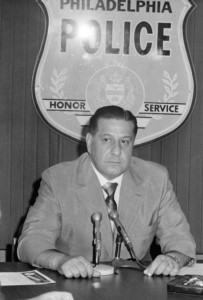
On May 13, 1985, police used C-4 explosives to blow up a home in a heavily populated Black neighborhood in Philadelphia, Pennsylvania. While undeniably a criminal act in and of itself, the cops then deliberately prevented the fire department from extinguishing the flames.
Over the ensuing four hours, the police and firefighters stood by, allowing three blocks around Philadelphia’s Osage Avenue to burn to the ground. In total eleven people died and sixty-two houses were lost.
While this specific incident may not be well known, similar state violence against oppressed communities is a daily reality –especially when working people unite and organize to fight back.
The house on Osage Avenue was the headquarters for an organization known as MOVE, which advocated respect for nature and was rooted in the tradition of the Black liberation movement. Founded by John Africa, MOVE members advocate self-sufficiency, living close to the environment, and honoring and remembering their African history. Hence, members take on the last name “Africa.”
In the repressive political climate of the 1980s, and in the aftermath of the rule of arch-racist Police Chief and later Mayor Frank Rizzo, MOVE became the target of state violence.
The MOVE bombing was carried out under the leadership of the city’s first Black mayor, Wilson Goode, but the campaign against MOVE began about a decade earlier under the Rizzo regime. In 1977, after years of cops beating and harassing MOVE members on the street, Rizzo ordered his police to maintain an around-the-clock “lock down” outside MOVE’s original home. These “checkpoints” and barricades were patrolled for the next 15 months by Philadelphia police brandishing SWAT-style, assault weapons. Rizzo told the press, “MOVE members will be taken by force, children or not!”
He then ordered the police to prevent anyone from bringing food or water into the MOVE home. Yet MOVE members continued to resist. The Mayor then ordered journalists out of the area, a signal of the violence to come that Rizzo did not want the press to report. When MOVE members attempted to negotiate, offering to peacefully relocate, Mayor Rizzo instead ordered the MOVE home be immediately demolished, fully aware it was still inhabited.
On August 8, 1978, police bulldozed the MOVE home while firemen flooded the building with water cannons. Police then opened fire, shooting directly into the building. In so doing, the police shot and killed one of their own.
The City used this cop’s death as a pretext to sentence nine MOVE members to prison for 30-100 years. To date, no city official has ever been charged for countless assaults on MOVE.
But the MOVE organization managed to carry on after the 1978 assault and relocate to a new headquarters. This was the target of the 1985 bombing in which 11 MOVE members including children, died on Mother’s Day, 1985.
Political prisoner Mumia Abu Jamal wrote “May 13th, 1985 is more than a day of infamy, when a city waged war on its own alleged citizens, but also when the city committed massacre and did so with perfect impunity, when babies were shot and burned alive with their mothers and fathers, and the killers rewarded with honors and pensions, while politicians talked and the media mediated mass murder. On that day, the city, armed and assisted by the US government, dropped a bomb on a house and called it law. The fire department watched buildings ignite like matches in the desert and cut off water. The courts of the land turned a blind eye, daubed mud in their socket, and prosecuted Ramona Africa for having the nerve to survive an urban holocaust, jailing her for the crime of not burning to death. Eleven men, women and children died, and not one killer was even charged with a misdemeanor.”
For the past three decades, houses along Osage Avenue remain primarily boarded-up and uninhabited. This is because, after the fires, the City deliberately “rebuilt” sub-standard housing along the street where MOVE’s second home once sat.
The bombing was the government’s attempt to intimidate and terrorize working and oppressed communities to prevent them uniting and standing up for themselves. It did not work, as recent demonstrations reveal. The Black Lives Movement continues to grow; protests against tar sands and for Indigenous sovereignty in the Dakotas have united environmentalists, Indigenous people and anti-war veterans.
And the three-decades-long campaign to free Mumia Abu Jamal has won important victories: first getting Mumia off death row, then getting him and other prisoners long-delayed treatment for Hepatitis C and now Mumia’s case has the possibility of being either re-tried or dismissed entirely. The same DA, Ronald Castille, who prosecuted Mumia thirty years ago refused to recuse himself when he became a top Appellate Court judge. In a clear conflict of interest, Castille was hearing appeals on his own prior cases.
Despite the horrible crime committed on May 13, 1985, the people continue to resist the racist establishment in Philadelphia and nationwide.





